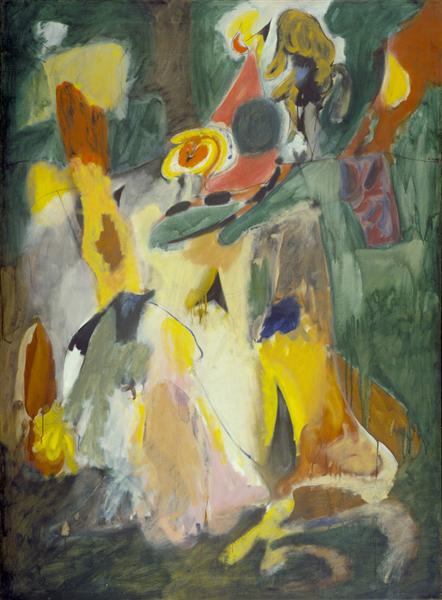Description
The painting "Cascada" (1943) of Arshile Gorky stands as a central work within the artist's trajectory, revealing with eloquence the tensions and possibilities of abstract lyricism that Gorky embraced throughout his career. In this piece, the viewer is submerged in a visual torrent where the movement of water translates into organic and fluid forms, evoking both the essence of nature and emotional anguish that characterized the artist's life at that crucial moment.
The "waterfall" composition is a celebration of duality. On the one hand, we observe a vital force that unfolds in a kind of dance; The waterfall becomes a symbol of fluidity and change, while, at the same time, the underlying structure suggests a monumentality reminiscent of primitive art. The forms are intertwined and overlap, becoming an amalgam of colors that sizzan and drip with an almost tangible energy. The use of soft curves contrasts with the dense and gloomy areas, creating a dynamism that invites the viewer to get lost in their visual interactions.
Gorky's palette in this work is rich and sophisticated, predominantly the earth's green, blue and the darkest tones that suggest depth and mystery. In addition, the yellow and white touches contribute moments of luminosity, as if the sunlight played between the water, illuminating the recesses of the work. It is in this interaction of colors that Gorky's technical mastery becomes evident, who combines the abstract with the figurative in a way that is deeply poetic.
However, it is important to recognize that "waterfall" also reflects Gorky's personal context. Starting his work in this painting around 1943, the artist was going through a tumultuous period, marked by loss and uprooting. The "waterfall" can be interpreted not only as a representation of nature, but also as a reflection on its own life; An attempt to channel the pain and beauty of its existence in a single image. This emotional complexity is a conductive thread in most of his work, reminding us that human experience is often a struggle between chaos and order.
Gorky is frequently recognized as a precursor to abstract expressionism, moving at the intersection of abstraction and surrealism. In "Cascada", the viewer can feel the presence of masters Like Paul Klee and Joan Miró, but also the influence of abstract art that began to bloom in his time. Gorky did not simply replicate these influences; They reinterpreted them through their personal lens, creating a unique visual language that has resonated with subsequent generations.
Throughout his career, Gorky dedicated himself to capturing the essence of his perceptions, seeking to explore the connection between art and his emotional context. "Cascada", with its intricate dance of shapes and colors, is not a simple representation of a natural phenomenon, but a vast emotional landscape that invites an interpretation that challenges the linearity of time and space. When observing this work, one immerses himself in an experience that transcends the visual and becomes an internal dialogue between the spectator and the object of art, carrying the concept of painting to new patamars of meaning. Gorky's work, especially "waterfall", continues to be a testimony of how art can encapsulate the complexity of human life and nature itself, in a symphony of color and form that resonates in each look.
KUADROS ©, a famous paint on your wall.
Hand-made oil painting reproductions, with the quality of professional artists and the distinctive seal of KUADROS ©.
Art reproduction service with satisfaction guarantee. If you are not completely satisfied with the replica of your painting, we refund your money 100%.

